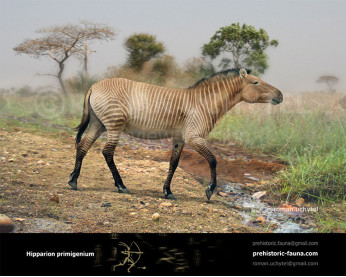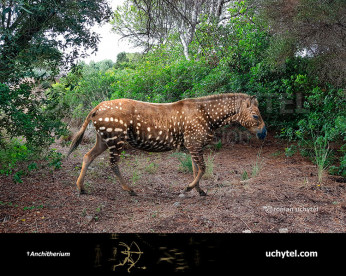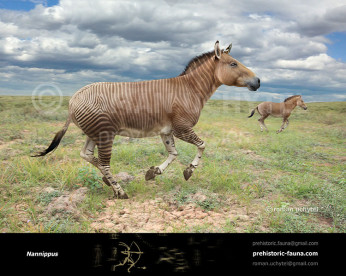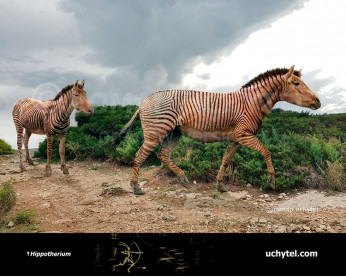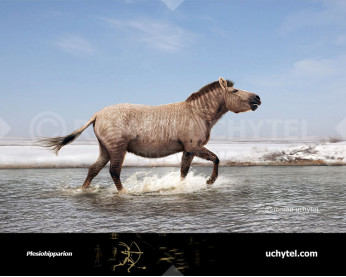Proboscidipparion pater
248248Proboscidipparion (†Proboscidipparion (Sefve, 1927))
Order: Perissodactyla
Family: Equidae
Dimensions: length - 2,3 m, height - 165 сm, weight -180 kg
Temporal range: dlived in Eurasia from the Pliocene (4 million years ago)
A typical representative: Proboscidipparion pater
Proboscidipparion is a horse extinct representative, who lived in China during the Pliocene. It was a quite large animal, the growth of a modern horse, which made it a giant compared with its closest relatives - hipparions. The main feature of Proboscidipparion was elongated skull with a bow, which is reminiscent of the same in the tapir. The nasal bones are shifted back, indicate the presence of elongated fleshy lips, or even a short proboscis. Molars and premolars were equipped with the large folds, which indicates that this horse was fed pretty tough vegetation. There were three functional hoof on its feet, making it possible to move on the hard ground as well as on the soft swampy ground. Proboscidipparion was first described in 1927 on the basis of the adult skull found in Langou, Henan Province in China. Proboscidipparions are often treated as a subspecies of the hipparions, representing the evolutionary line of this group of horses. They probably originated in Asia during the Pliocene and early Pleistocene lived to see, representing one of the last representatives of the hipparions. On the basis of occurrences of bones and animal morphology, it is assumed that Proboscidipparions prefer to live near rivers and lakes, and their way of life could be similar to the way of life of tapirs.
Proboscidipparion (†Proboscidipparion (Sefve, 1927))
Order: Perissodactyla
Family: Equidae
Dimensions: length - 2,3 m, height - 165 сm, weight -180 kg
Temporal range: dlived in Eurasia from the Pliocene (4 million years ago)
A typical representative: Proboscidipparion pater
Proboscidipparion is a horse extinct representative, who lived in China during the Pliocene. It was a quite large animal, the growth of a modern horse, which made it a giant compared with its closest relatives - hipparions. The main feature of Proboscidipparion was elongated skull with a bow, which is reminiscent of the same in the tapir. The nasal bones are shifted back, indicate the presence of elongated fleshy lips, or even a short proboscis. Molars and premolars were equipped with the large folds, which indicates that this horse was fed pretty tough vegetation. There were three functional hoof on its feet, making it possible to move on the hard ground as well as on the soft swampy ground. Proboscidipparion was first described in 1927 on the basis of the adult skull found in Langou, Henan Province in China. Proboscidipparions are often treated as a subspecies of the hipparions, representing the evolutionary line of this group of horses. They probably originated in Asia during the Pliocene and early Pleistocene lived to see, representing one of the last representatives of the hipparions. On the basis of occurrences of bones and animal morphology, it is assumed that Proboscidipparions prefer to live near rivers and lakes, and their way of life could be similar to the way of life of tapirs.

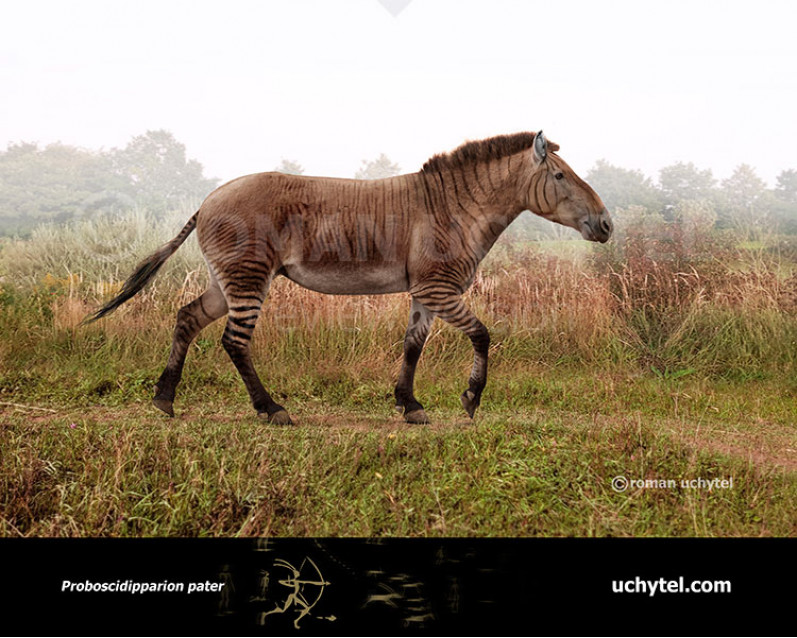
-1-797x638.jpg)
1-797x638.jpg)
-797x638.jpg)

-1-70x56.jpg)
1-70x56.jpg)
-70x56.jpg)
